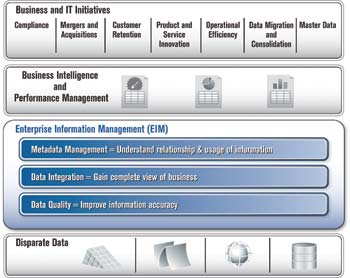LESSON - The W5 of Enterprise Information Management
By Darren Cunningham, Product Marketing Director, Business Objects
Enterprise information management(EIM) includes the strategy, practices,and technologies that allow organizationsto manage disparate data effectively. Theright approach to EIM will help drive individualand organizational performance,enable business intelligence (BI) standardization,and ensure that relevant andtimely information is delivered to businessusers in a way they understand. But whenyou think of EIM, it’s important not tothink of it just as middleware. Instead, youneed to consider “middle-where,” “middlewhy,”“middle-what,” “middle-when,” and“middle-who?”
Middle-Why?
If your goal is to become a high-performanceorganization, where people areconnected to common metrics, goals, andstrategies, you must not underestimatethe importance of the underlying datafoundation. Is your organization seekingto attract and retain skilled workers? Areyou hoping to acquire new customers? Isyour company aiming to increase shareholdervalue while continually adaptingto rapidly changing market conditions?Do you want to use IT to reduce costs andcreate more value?
For most organizations, the answerwould be a resounding, “Yes!” The workdone behind the scenes—the work thatend users never see—will be the key tothis success.
Middle-Where?
Determining what your business usersrequire and what tools they’re using todayis critical to an EIM strategy. A toolsand-skills audit will give you the currentpicture and allow you to develop a longtermvision and plan on how to reachyour BI goals. Knowing where to focusfirst (department, geography, level, etc.)will also help you get some early winsand establish credibility as you roll outinitiatives like performance managementdashboards and scorecards. Focus on thebottom (systems and data), top (users),and middle (data quality and integration).
Middle-What?
Whether it’s a data warehouse or datastore, there are many tools available tohelp you physically or virtually move dataand make it relevant to BI users. ETLtools are used to move large volumesof data in batch from multiple sourcesto targets, and EII tools enable federatedquerying capabilities across systems.Either way, the right EIM strategy helpsto solve data centralization, reconciliation,and efficiency issues. Without dataquality, there is no end-user confidenceor trust in the numbers. Many organizationsare now creating the role of the datasteward to help deliver what essentiallybecomes a “data quality firewall.” Masterdata management (MDM) practices usetechnologies to provide a layer of standarddefinitions about the business (customer,product, sales). Some organizations areimplementing MDM for data quality purposes,helping them to transform data to acommon standard.
Middle-When?
When it comes to EIM, don’t wait to getstarted. That does not mean you shouldsimply pour more resources into newtools. An EIM strategy that is directly tiedto your BI and performance managementinitiatives will begin with the end in mindand enable you to architect a solutionbased on the unique information accessand analysis requirements of your entireBI user community.
Middle-Who?
The key to the right infrastructure and a comprehensive EIM strategy is both data neutrality and data proximity. Make sure your vendors are able to take advantage of your transactional systems, but are not inherently tied to them in terms of key features and benefits. From a BI, dataintegration, and data-quality perspective, it is critical to choose components that are tightly integrated. Few vendors can claim to deliver everything in an integrated way, so ask them about the depth and breadth of their product and services offerings, and seek to establish the elusive “trusted advisor” relationship with a select few.

Enterprise information management: Strategy, practices, and technologies to effectively
manage disparate data and drive performance.
This article originally appeared in the issue of .